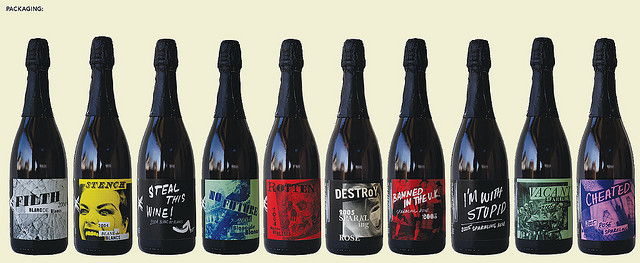Yet another Mollydooker wine, yet another custom domain name. Before I begin this time, I’d like to quickly discuss the 2007 Carnival of Love Shiraz, which I finished drinking last night and which led me down a rabbit hole of snide one-liner reviews: Good, but not $85 good. Penfolds St. Henri, but with a shot of grain alcohol. Lovely Shiraz with well-judged oak, but at triple the cost of its competitors. In short, it was a good wine, not great: rich Shiraz fruit without any of the annoying complications of terroir, subliminal oak that helped rather than hindered, once again too much alcohol, and on the whole a perfectly enjoyable wine unless you earn less than six figures and/or prefer moderate alcohol levels, in which case, well, you’re SOL.
Now: on to this wine. Once again, my heartfelt thanks to the good folks at Mollydooker for sending press samples my way; I’m sure they were hoping (as was I) for happy drinking, and I’m pleased to say that I’m finally as near my happy place as I’m going to get. Once again, though, I’ll point out that the cost is well into ridiculous range (you can buy Clonakilla shiraz viognier or Ridge Monte Bello for less money than this), and the alcohol is stratospheric (although thankfully not as noticeable on this wine). And with that, I’m done whingeing. On to the good stuff.
Many, many years ago, shortly before I decided to enroll in the Central Washington University World Wine Program, I attended a tasting in Seattle that was led by the CWU professor responsible for founding their wine program. One of the gentlemen in that afternoon’s tasting – I suspect he was a doctor, lawyer, or someone else with an awful lot of money – expressed concern about a pinot noir’s color – surely something that pale couldn’t possibly taste good? Well, sir, if it’s rich, satisfying, tooth-staining color you like, I’m happy to report that this wine has an awful lot of it, period. Once again we’re dealing with a squid ink black, opaque, monster of a wine, but the color is slightly different than the other Mollydookers: not quite older, but it’s optically slightly less transparent at the rim and with a more usual color to it.
The nose is wonderfully complex; at first, I was reminded of an off-season seaside hotel on the coast of Spain: iodine notes, plus fading fruit, battered wood, fruity esters, the remaining spice from summer guests’ colognes, and all kinds of other interesting things. The one thing I’m reminded of the most is (strangely enough) Comme des Garçons Odeur 53, an avant-garde anti-perfume that is said to contain notes along the lines of ‘dust on a lightbulb’ and ‘pure air of the high mountains’ – in short, lots of highly improbably, artificial things that really shouldn’t be in a perfume. Similarly, not a lot of what I smell in this wine reminds me of traditional wine smells: no obvious Bordeaux toast, raspberry motor oil fruit, etc. Instead, you get a hundred variations on dislocation. There’s a lot here which tends towards the plastic, the cosmetic, the confected, the surreal, but it works just fine in context, strangely enough: at times, it does settle back down into nearly recognizable shiraz-cabernet territory with a whisper of spicy oak, but only briefly.
With alcohol levels this high, the wine does turn hot towards the middle of the palate, which is moderately unpleasant; however, the rich, unctuous, mouth-filling sensuality of the wine is undeniably powerful; even if you’re intellectually opposed to it on grounds of, say, perverting terroir, you’ll still enjoy it, honest. Tannins are forcefully present again, softening slightly, with a slight suggestion of (somehow) harder, unripe tannin that works nicely against the lushness of the fruit. Finally, there’s something almost marine about the very finish… or it could be umami, in which I’m making a very weak connection to seaweed here. It’s definitely porty, with a certain sweetness that goes on for quite a while after swallowing, which might just work with fatty dishes like foie gras.
Taking a tip from their marketing materials, I also tried some of this wine with a handful of Marconi almonds… and they’re dead on correct. Strangely enough, the combination manages to arrive at butter pecan ice cream: rich, creamy fruit with hard, salty nuttiness – absolutely delicious. The salt and fat help cut the alcohol and fruitiness of the wine; I imagine this would be absolutely fantastic with steak.
In short, pretty damn good wine. However, I’ll once again state that there’s too much alcohol, it doesn’t taste like any particular place, and (most importantly) I expect a fully transcendent experience for this kind of money… and it falls short of that. Still, I would gladly drink this … if it were half the price.As an aside: in terms of reviews, I see that this is a Wine Advocate 95 and a Wine Spectator 91. The Spectator is correct: this is a good wine. But the Advocate is just wrong: this is not otherworldly.
Mollydooker
Price: $85
Closure: Cork
Source: Sample
